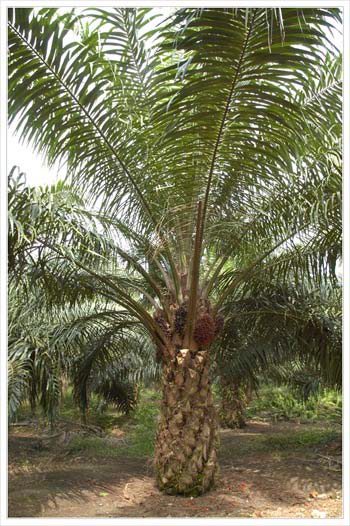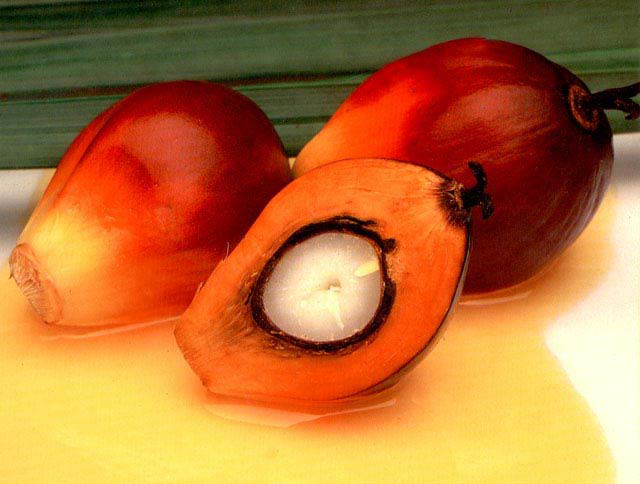Indonesia is one of the largest palm oil producing countries, supplying almost half of the world’s palm oil. Palm oil is widely used as vegetable oil for cooking, in food products, an ingredient
for candles, body care products, soap, detergents, grease and lubricants for machinery in the industrial sector and as biofuels. Manufacturers and producers choose palm oil over other types
of oil because palm oil gives a higher yield per ton of fruits
An individual palm oil fruit consists of the outer skin (the exocarp), a pulp (the mesocarp), a central nut consisting of a shell (endocarp), and the kernel. The weight of an individual fruit ranges
from six to twenty grams. The exocarp is the very outer skin of the individual fruit. The mesocarp is the orange yellowish part in the middle (see Figure 2), between the exocarp and endocarp.
This part is the main ingredient for palm oil, which gives the carotenoids in the oil. The endocarp is the black circle surrounding the kernel. It is the inside shell of palm oil fruits that protecting the kernel. The kernel is the white part in the middle of the fruit. This part is used in palm kernel oil. On the tree, the individual fruits are in a bunch together. The weight of a fruit bunch varies between ten to forty kilograms. Fruit bunches usually are sold from the farmers to the processing plants. Before processing, the workers separate all the individual fruits from the bunch.
With the significant increase in the consumption of palm oil during the past few decades,the palm oil industry has responded to the demand by expanding extensively. This growth was driven by ever-increasing global demand for edible oils. The past few decades have seen rapid expansion in the production of two major edible oils, soybean oil in South America and palm oil throughout the tropics and stretching into the sub-tropics. This rapid expansion has been able to provide the world with its increasing demand for vegetable oil and because of the palm’s productivity at a price, which is affordable to rising needs in third world countries. It presented itself as a cheap and reliable product for countries. Even with many different substitutes of oilseeds and other commodities, the production has expanded tenfold since 1961 (FAOSTAT2009). The expansion of the industry is supported by the high productivity of palm oil, yielding more oils per hectare than other oilseed commodity. Through the analysis of rattan, rubber, and palm oil in East Kalimantan, Indonesia, Belcher, Rujehan, and Achdiawan (2004) computed the net present value and other financial analysis of each commodity. The study was conducted to look at the changing use and management of forest product in East Kalimantan because the traditional land-use was under pressure by a range of factors, including government policy.the result shows that palm oil gives the best of the land use options, when considering the profitability per unit of land compared to rattan and rubber.
Another reason why the producers choose palm oil over other oilseeds is because palm oil is cheaper compared to other oilseeds; especially soybean. Palm oil also can be used as a major component of consistent or solid fats without hydrogenation, which requires only a little reprocessing before use and possesses specific property of value (Berger 1986). In addition, palm oil is semi-solid at room temperature, making it ideal for baking and food production. Many food manufacturers are trying to find alternatives to trans-fat, partially hydrogenated oils, which contribute to heart disease and other medical problems. Although palm oil is not directly contributed to heart disease, the focus on the trans-fat issue has resulted in palm oil being considered more healthful than some other fats. Berger lists and compares products that use oil (palm or soybean) as one of their ingredients. He explains a number of specific food applications and formulas related to the use of palm oil. A palm mid-fraction is highly compatible with cocoa butter. The producers have a wide range of options when processing palm oil fruits. As Berger mentions, the producers are not competing in the same level of playing field because of this wide range of options. For example, soap is the largest user of the fat in palm oil because palm stearin is competitive with tallow in price. It also offers cost savings because it requires less clean up for soap manufacturers. Not only the fruits can be used as oil, but also the byproduct from the oil processing can be converted into other products. The possibility of using the byproducts will maximize the use of palm oil fruits.


